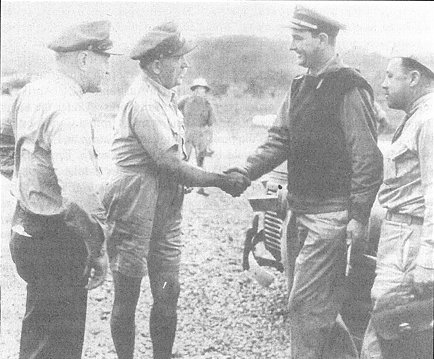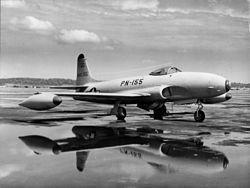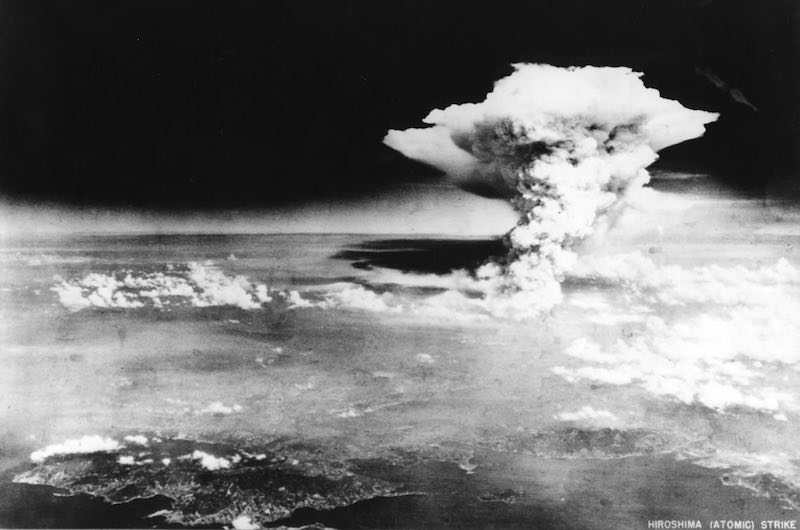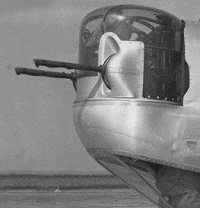
B24 front office: nose guns
The B24 was sometimes called the "Flying Coffin" because of its stiff and heavy controls, and because the only entry and exit from the aircraft was in the rear and it was almost impossible for the flight crew and nose gunner to get from the flight deck to the rear when wearing parachutes.

"24 Dec 1944, Over Clark Field, Luzon:
A 90 mm shell had entered just aft of the bomb-bay and exploded inside the airplane, killing radio operator T/Sgt. Paul Deis instantly.
Waist gunner, Sgt. Vernon J. Farup, was trying to help the injured. Fifty-caliber machine gun ammunition in the waist position was exploding in all directions.
Sgt. Farup threw the ammo boxes out the waist windows." [Photo: Bunting] [Text: Hulme (Pilot)]
[Aircraft: B-24 44-41277]
How this could have turned out
Video: B-24s attack Luzon: Watch
USAAF Training Video: Flak Watch
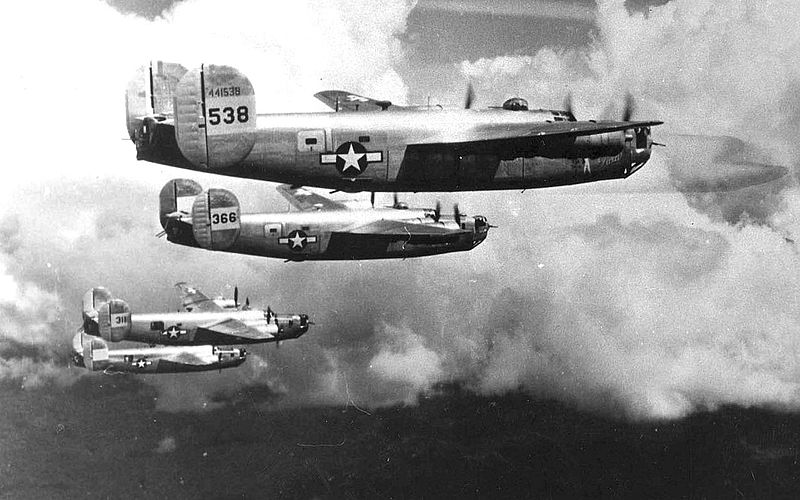
B-24 aircraft of the 33rd Bomb Squadron 22nd Bomb Group on a mission
- The first aircraft (B-24L 5-CO 44-41538) is "Round Trip Ticket" (crashed at Okinawa 26 Aug 1945)
- The second aircraft (B-24J 160-CO 44-40366) is "Gypsy/Slightly Dangerous" (flew 121 missions)
- The third aircraft (B-24J 205-CO 44-41311) is "Sleepy-Time Gal"
The mission
The WWII Combat Chronology of the US Army Air Forces cached here includes this entry for the Southwest Pacific Area (Fifth Air Force) for 9 June 1944:
"B-24s bomb the airfield on Peleliu Island, Palau Islands. In New Guinea, A-20s bomb shipping in Manokwari harbor; B-24s, A-20s, B-25s and P-39s, along with RAAF planes, drop about 140 tons of bombs on various targets in the Wewak area; and 39th Fighter Squadron, 35th Fighter Group, moves from Gusap to Nadzab with P-47s. B-24s of Thirteenth Air Task Force bomb Alet Airfield and targets of opportunity in Truk Atoll."
This page describes the 10 hour flight from Wakde Island to bomb the airfield at Peleliu Island in the Palau Islands on 9 June 1944 from the perspective of the crew of one of the aircraft involved (two aircraft did not return). The description is based on a citation - however the medal was not approved as the mission was considered to be "business as usual" for a B-24 crew in the Pacific.
Lloyd Bunting's Crew
A B-24 has a crew of 10 and 12 stations (roles): Pilot (Robert W. Hulme), CoPilot (L.J. Sperry), Navigator (Byron K. Wilson), Flight Engineer, Radio Operator, Bombardier, Nose Turret Gunner (Lloyd Bunting), Top Turret, Ball Turret, 2 Waist Gunners, Tail Gunner. The B-24 in this story is referred to by the pilot as tail number 318 (Consolidated B-24J-90-CO Liberator serial number 42-100318 "Titian Temptress ).
Peleliu Island
Peleliu Island (Peliliu, Bliliou, Beliliou) is one of many islands in the Palau Group. Peleliu Island is 5½ miles long, 2½ miles wide, and 5sq miles total area, with an airfield in the south and a swamp in the east Map. Four months after Bunting's flight, 13,000 people were to die in a battle for this island. These included 98% of the 10,900 Japanese defenders.Wakde Island
Wakde Island was one stepping stone along the North coast of Hollandia (West New Guinea) More Map. The airfield was built by the Japanese before it was taken by the US Army on 15 May 1944. The airfield was being bombed by the 5th AF as recently as 5 May 1944, and Japanese targets on Wakde Island were being bombed up to 1 June 1944. The 5th AF began moving to Wakde on 22 May 1944. On the night of 5-6 June 1944, just 4 days before the cited flight, an air raid by two Japanese G4M Betty bombers destroyed six 5th AF aircraft at Wakde: one B-24 bomber, four P-38 Lightning fighters and one L-4B Grasshopper spotter. 80 other aircraft were damaged.Aircraft included:
- 42-100180
- 42-100318: "Titian Temptress"
- 42-100291: "Ole Tomato"
- 42-100328
- ...974
Col. Richard. W. "Robbie" Robinson
Became CO of the 22nd Bomb Group on 28 Dec 1943. Killed 21 Jan 1945 aged 26.
Taking off on a mission from Samar to bomb Heito (Pingdong) air base Formosa (Taiwan),
Robinson's B-24 hit a parked Corsair and crashed at the end of the runway, killing all the crew. More

A Corsair at Eastern Samar
Corsair development and Pacific role Watch
Eye witness account:
"I was to lead "B" Flight right behind Col. Robinson.
As we taxied into position for take-off, a thunderstorm broke over the field.
At that time, a squadron of Marine Corsair fighters were located on Samar to protect the base.
Some of them were taking off.
The control tower advised them, via radio, to clear the runway so the "Box-Cars" could take off.
It was raining so hard you could barely see.
About half-way down the runway a Corsair pulled over to the side.
He thought he was clear. He wasn't.
Col. Robinson, not wanting to delay the takeoff, poured the coal to his plane.
His left wing clipped the Corsair and about nine feet of it was torn off by the impact.
Col. Robinson was beyond the point of being able to stop.
A See-Bee was on a huge bulldozer at the end of the runway.
He was working to make the runway longer.
Col. Robinson tried to pull his ship off the end of the runway.
He didn't make it and crashed into the bulldozer.
The eight 1,000 pounders that he was carrying exploded.
There wasn't much left. The mission was called off."
Robert Hulme Report
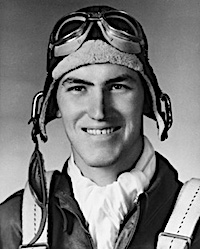
Robert Hulme
Eye witness account:
"Supposed to be a big strike against a Japanese airdrome at Formosa.
(Robinson) was a kind of a gung-ho guy. He was flying in the co-pilot seat.
And we were the second plane to take off - he was the first plane.
So I was watching - I always had the hatch open until the first plane took off,
and then I'd lock the hatch, and then we'd wait 30 seconds and take off.
And I saw (Robinson's) plane go down the runway and all of a sudden he'd got about 100 feet down the runway
and he started veering off to the right.
And there was a whole bunch of Marine fighter planes over on the side,
and he hit about 10 of those planes and the plane blew up.
He had 10,000 pounds of bombs and full of gas and that thing exploded."
Henry Kuhn, Video: 33m24s
Action in the Bismark Sea (2 Mar 1944)
The mission to Peleliu on 9 June 1944
Mission Description
Written by by Lt. Col. Robert W. Hulme, USAF (Ret.), at the time Hulme was 1st Lt, pilot. Original
"The 22 Bomb Group took off fully loaded from Nadzab, New Guinea, and flew to Hollandia on the afternoon of June 8, 1944. Before daylight on the 9th we took off for Wakde Island to re-fuel and be briefed for the mission. Before we reached Wakde, the radio there said "Bandits in the area. We are under attack. Boxcars go back to where you came from." I returned to Hollandia and again landed with a full bomb load (which I didn't particularly relish) for the second time on this mission. No sooner were we on the ground than Wakde radio advised that the area was clear. We took off again and flew to Wakde. While ships were being refueled we had another briefing. Because of Jap raids, the ground defenses were getting trigger happy. Each ship was given a letter in Morse code that we were to flash when we returned to Wakde Island, which was a coral island about 5000 yards long and half as wide. We were also advised to approach from a small island five miles north of Wakde.
Twenty-eight B-24's took off for Palau around 10 a.m. June 9, 1944. Several ships turned back for various reasons. About twenty minutes before we reached the target only seven ships remained. Col. Robinson was flying lead. Frank Mims was on his left wing and I was flying #318 on his right. George Jacobi, B flight leader (with no wingman – they had aborted) was flying in the "bucket" directly behind and below Col. Robinson. The 33rd squadron leader and two wingmen were behind Jacobi. About this time a black Zeke appeared on our left out of machine gun range. He flew there for several minutes without attempting to attack. Then the stuff hit the fan! We were attacked from all directions by Tojos and Zekes. Towering cumulus clouds were in the area. So Col. Robinson skirted those to keep the fighters on one side. Over target ack-ack was intense. The pilot of the 33rd squadron forced Jacobi out of "B" lead position, so Jacobi flew on my right wing over the target. It has always been my impression that the 33rd lead ship was shot down over the target. Japs harassed us for several minutes after bombs were away. Several were believed to have been shot down. Finally they disappeared. Were we glad! The weather continued to worsen. It was like flying in a heavy fog. I had to stick close to Col. Robinson in order to see him. We flew several hours like this until all at once we were in a thunderhead. I couldn't see anything. I banked sharply to the right to avoid collision with the Col. For an incredible time L. J. Sperry, co-pilot, and I tried to keep the plane in flying altitude. We were both on the controls with all our strength. The air speed indicator would vary from 50 to 300 mph. Altitude would vary thousands of feet. We flew every heading on the compass, using artificial horizon. Every other instrument on the panel was going crazy. After an eternity we were flying in heavy rain but turbulence had subsided. We were 500 feet over the ocean and had no idea where we were. I asked B. K. Wilson, navigator, for a compass heading. He gave me one. About ten minutes later another 15 degree correction. I told the radio operator to see if he could raise Wakde. He told me that our radio was out. I sent Sperry, who had been a radio operator before he took pilot training, to go back and help the radio operator fix the radio. After he went back the #3 engine sputtered and almost stopped. I hollered to the engineer to switch the gas supply and told Sperry over intercom to come back to his position. Another engine sputtered. About this time it was dark and I saw a light ahead. I got on the intercom and told the crew that I had seen light and it might be a Jap ship or American. In either case, prepare to ditch. Would you believe that it was Wakde Island! We were approaching from the south. I told the copilot to drop the landing gear and flaps. We made a straight-in approach and landed, expecting any second to be fired on by ground defense. When wheels touched the runway every one shouted at the top of their lungs! I pulled off the end of the runway and cut the engines. A full Colonel pulled up in a jeep. He had a quart of rye whiskey. A gas truck pulled up to refuel old #318 while we killed the quart. We had 55 gallons of fuel left when we landed.
About this time a B-24 approached from the north. He was 300 feet above the runway. It was Frank Mims on three engines. He lost one over the target. Incredibly he got #974 on the ground and pulled off the side of the runway. Then another B-24 approached from the same direction as I had, the south. The runway sloped down to the edge of the ocean. Col. Robinson landed under the slope and washed his landing gear out. We flew back to Nadzab, New Guinea, the next day.
Forty years later I saw Byron K. Wilson, the navigator, at a squadron reunion in Panama City, Florida. I asked B. K. how he knew what headings to give me that night in 1944. He said, 'Bob, the man upstairs was navigating for us that night.'"
Citation
HEADQUARTERS2ND BOMBARDMENT SQUADRON
22ND BOMBARDMENT GROUP (H)
AFO 713 Unit #1
AC 201 - BUNTING, Lloyd H. (Fol) 20 June 1944
SUBJECT:
Recommendation for Award of the Distinguished Flying Cross.
TO:
Commanding General, Fifth Air Force, AFO 925 (Thru: Channels).
- Under the provisions of AR 400-45, War Department, Washington, D.C., dated 6 August 1932, as amended, it is recommended that S/Sgt. LLOYD H. BUNTING, 11010818 (Nose turret gunner), 2nd Bombardment Squadron, 22nd Bombardment Group (H), be awarded the Distinguished Flying Cross for extraordinary achievement while participating in an aerial flight over Palau Island on 9 June 1944.
- At 1030/K on 9 June 1944, five B24J type airplanes of this squadron took-off from Wakde Island on the longest continuous over water mission yet performed by the 22nd Bombardment Group (H). The mission was to be flown entirely without fighter escort despite the fact that enemy interception was probable from take-off to landing. The most reliable reconnaissance of the target and vicinity was months old and there was no current information regarding the weather to be encountered. S/Sgt. LLOYD H. BUNTING was flying as the nose turret gunner in the number "2" plane of the lead flight. After encountering instrument weather on three separate occasions enroute to the target, and having one airplane turn back due to mechanical failure, the target was sighted at 1545/K. Within the next fifteen minutes, the formation was attacked by sixteen enemy fighters. The first "Tojo" came in from 11 o'clock low. Sgt. BUNTING from his big nose guns scored hit and the fighter broke away over the formation. A second "Tojo" attacked from 12 o'clock high. This fighter pressed the attack to within 600 yards and then passed under the formation. Sgt. BUNTING and the nose turret gunner in the lead plane caught this fighter in their cross fire scoring several hits in the fuselage and tail. The next fighter to attack also came from the front and passed under the formation. At one time during the flight, a gun jammed on Sgt. Bunting. This running fight with the enemy fighters continued for more than thirty minutes with attack after attack coming within range of Sgt. BUNTING's guns. By 1630/K the formation had reached the first weather to be encountered on the return trip and at this point the enemy fighters turned back. For the next hour and a half, Sgt. BUNTING's plane proceeded through rain and sleet. At 1800/K a severe cold front was entered. The rain and sleet were so intense that it was no longer possible for one to see the lead ship of the formation, so the pilot altered course to avoid a possible mid-air collision. The weather was so turbulent that it took the full physical effort of both the pilot and co-pilot to keep the plane under control. By this time the pilot had the plane down to 1500 feet over the water trying to escape the turbulence. Here the number three (3) engine cut out because the gas was very low. By turning on the fuel booster pump, the engine was started again. At 1930/K Sgt BUNTING's plane broke out of the front about ten miles east of Wakde Island. Proper recognition signals were made and permission to land was obtained. The landing was accomplished at 2020/K on 9 June 1944. For his extraordinary achievement while participating in this aerial flight and for the excellent manner in which he continued to carry out his duties in the face of extremely hazardous conditions, S/Sgt LLOYD H. BUNTING is recommended for the highest honor.
- The mission cited has not been used as the basis for a previous award, and will not be used as the basis for a future award.
- The service of Sgt. BUNTING subsequent to this mission has been entirely honorable.
- At the time of these services, Sgt. BUNTING was an enlisted man in the armed forces of the United States.
- The undersigned, flying as pilot on this crew was an eye-witness to the above deeds.
- All the crew members are being recommended for the award of the Distinguished Flying Cross for their participation in this mission.
- Home address:
Mr. Lloyd H. Bunting (Father)
72 Midchester Avenue
White Plains, N. Y.
ROBERT W. HULME
1st Lt., Air Corps.
AC 201 - BUNTING, Lloyd H. (2nd) 1st 1md. 23 June 1944
Headquarters, 2nd Bomb Sqdn., 22nd Bomb Gp (H), AFO 713 Unit #1.
TO:
Commanding General, Fifth Air Force, AFO 925 (Thru: Channels).
Approved.
(Unsigned)
RUSSELL G. ALLAN
Major, Air Corps,
Commanding.
Video
22nd BG Mission to Palau (raw fotage): Watch (0:33) (No sound)
Same Mission to Palau (raw footage): Watch (2:14) (No sound)
More: B-24s bomb Palau (raw footage): Watch (3:19) (No sound)
B-24 support for landing on New Britain (Rabaul): Watch (3:05)
Action at Angaur: Watch (28:27)
Notes
The pilot, Bob Hulme, left the USAF as a Lt Colonel. He died on 13 Jan 2011. He is also mentioned in another combat description: HereSome didn't make it home
28 aircraft took off from Wakde for the mission to Peleliu on 9 June 1944. Only 7 made it to the target. Several of the aircraft involved in the mission did not return. These included:
"B-24J 42-100180 (MACR 13285): Damaged by enemy fire during an attack on Peleliu, the aircraft ran out of fuel while returning and ditched about a mile from Aitape Point, New Guinea. S/Sgt. William J. McCrosky was killed by gun fire during the attack. The body of another unidentified crewman washed ashore on the following day; four others disappeared after reaching shore. Lost were Lt. Francis J. Washington, navigator; Lt. Elden E. Hamilton, bombardier; T/Sgt. Warren J. Carstens, radio operator; Sgt. Warren R. Brunn, asst. radio operator; and S/Sgt Carmen Barreca, gunner. Pilot: Capt. John N. Barley."
- Update: PacificWrecks.com reports that the plane was hit by Japanese fighters and ditched about a mile offshore near Sissano Lagoon near Tadji. More
"B-24J 42-100328 (MACR 5870): Became separated from formation by weather while two hours from target, an airfield on Peleliu, and was never heard from again. Lost were Lt. Howard F. Vierling, pilot; Lt. Eugene W. Sengstake, co-pilot; Lt. Albert E. Carpenter, Jr., bombardier; Lt. William H. Crockett, navigator; Sgt. Elmer C. Richardson, engineer; Sgt. Jewell C. Spicer, radio operator; Sgt. Garland L. P. Grant, asst. engineer; Pvt. Dilworth P. Lund, asst. radio operator; Sgt. Felix B. Lezynsli, gunner; and Sgt. Stephen Lilak, gunner."
Charles Lindbergh at Wakde
Charles Lindbergh (of Spirit of St Louis fame) was stationed at Wakde Island a week after Bunting's 10 June flight. Lindbergh was trying to increase the range of P-38 fighter aircraft to provide escorts for B-24 missions to Palau. On 1 August 1944 he and 3 other P-38s managed a round trip from Wakde to Palau, but Lindbergh was nearly shot down by the Japanese. MoreRisks in Pacific aerial operations
One of the greatest problems for Pacific aerial operations was the weather.
On 16 April 1944 (Black Sunday), just 8 weeks before the cited flight, a weather front blocked the return of 170+ B-24s, B-25s and A-20s from a raid on Hollandia. Bad weather and accidents closed all available fields as a line of thunderstorms blocked access to landing sites.
By the time it was over, 37 aircraft were destroyed or missing and another 9 seriously damaged due to navigational errors, the weather and consequential confusion (incl collisions in the air and on the ground).
B-24 Pilot Robert Hulme's account of Black Sunday
" A tropical front – we were within two hundred miles of the equator – had closed in. We couldn't get to the pass where we were to cross the mountains. The squadron leader advised us to proceed on our own.
Our ship turned back toward the coast and decided to follow the northern coast of New Guinea southeast around the Huon Peninsula to Lae, then fly up the valley to Nadzab. This option had a serious problem, too – our destination was about two hundred miles farther away. We didn't have enough gas; so we decided to follow the coast until we ran out of gas and ditch near the shore.
When we were about out of gas, we noticed much commotion ahead. U.S. aircraft of all descriptions were buzzing around Saidor, a small Fighter airstrip east of Madang. The whole 5th Air Force was trying to land there. The control tower, mounted on coconut palm poles, was trying to direct traffic with a "biscuit gun" – a six inch light with green and red lenses. Green meant clear to land; red, go around.
No one was paying any attention to the control tower. We made a straight-in approach and landed. We pulled up into the revetment area as far as we could. Aircraft of all kinds were lined up ahead of us. We cut our engines and climbed out.
I have never seen such a mess. Airplanes were ditching along the beach. Some were parachuting above the field. One crew that ditched and parachuted landed about a mile from the field. It took them a month to hack their way out of the jungle.
I looked back to the landing strip. A B-25 was landing. A P-38 was landing from the opposite direction. They tried to miss each other in the middle of the strip. They didn't. Their wings clashed, and they spun around in flames. Ammunition was exploding in all directions. Other ships, in landing patterns, attempted to miss the wreckage as they landed. They didn't and piled up too."
Aircraft types lost included:
- A-20G Havoc: 3rd Attack Group: 7
- A-20G Havoc: 312th Bombardment Group: 4
- A-20G Havoc: 417th Bombardment Group: 5
- B-24D Liberator: 43rd Bomb Group (H): 1
- B-24J Liberator : 22nd Bomb Group (H): 4
- F-7A (modified B-24): 6th Photo Reconnaisance Group: 1
- B-25D: 38th Bomb Group: 3
- B-25D: 345th Bomb Group: 3
- B-25G: 38th Bomb Group: 1
- F-7A (modified P-38): 6th Photo Reconnaisance Group: 1
- p-38J: 475th Fighter Group: 11
- P-39Q: 71st Tactical Reconnaissance Group: 1
- P-47D: 348th Fighter Group: 1 (parked, but victim of a collision)
51 lives were lost:
- A-20G: ditched: 2 survived the ditching but were lost at sea
- A-20G: ditched: 2 did not escape the plane before it sank
- B-24J: never seen again (last sighted over mountains or sea): 20
- B-24J: crashed: 7
- B-24J: bailed out: 2 were never found
- B-25D: never seen again (last sighted over mountains or sea): 1 complete crew
- B-25D: collision in the air: 1 complete crew
- F-5A: collision in the air: 1
- P-38J: collapsed after successfully avoiding a collision on the ground: 1
- P-38J: never seen again (last sighted over mountains or sea): 3
- P-38J: execution by the Japanese: 2
- P-38H: crashed into the sea: 2
Only 2 days before the mission cited above, only 10 out of a flight of 48 B-24s managed to beat the weather to hit targets on Truk Atoll.
The risks were many, including mechanical failure anytime from takeoff to landing, enemy aircraft, anti-aircraft defences (flak), weather, pilot and navigation errors, fuel shortage, collision, sticky runways (preventing planes from reaching takeoff speed), and even prop wash, gunfire, or bombs from other friendly aircraft.
A whole world of further risks awaited the crew of any aircraft that did not complete a mission, including injury or death from battle or the impact, drowning, shark attack or exposure at sea, execution or other consequences of imprisonment by the Japanese.

PBY rescues survivors of ditched 2nd Sqn B-24. 26 Jul 1944.
Crew: Pilot WJ Amos, Co-Pilot WA Rush, Navigator L Moore, Engineer HW Talley, Radio BM Gonzales.
Bombardier J. Bishop died after rescue and was buried at sea.
Other crew members were killed on impact. Story Story
A future President has a close shave with the 22nd Bomb Group - takes home Silver Star
Lt Cmdr Lyndon Johnson, USN (later President of the United States) was personally awarded an Army silver star by General MacArthur for a flight with the 22nd Bomb Group on 9 June 1942.
At the time LBJ was a VIP on a study mission. He wanted to obtain personal experience of combat action, and was one of a party of 5 observers on a combat mission from Port Moresby to Lae in New Guinea.
The intention was to make LBJ's flight a 'picnic', with decoy B17s to lure fighters away from the VIP flight. However the Japanese Zeros attacked the VIP flight hitting 6 of the 11 B26s. LBJ had been scheduled fly on #40-1508 "The Virginian" but lost his seat to another member of the VIP party. He therefore took a seat in #40-1488 "Heckling Hare".
After leaving the target "The Virginian" tried to outrun the Japanese fighters at full throttle at 30 feet above the water (to prevent attack from below) but, with a badly smoking left engine, "The Virginian" crashed into the sea at 300mph, cartwheeling and disintegrating with the loss of all on board. There is a report that it crashed into the sea because it was boxed in by 3 other B26s.
30 minutes into the mission LBJ's plane, the "Heckling Hare", had aborted the mission due to engine (generator) failure. None of the crew were awarded medals for that flight, however for coolness as a passenger in the plane, LBJ picked up a Silver Star. As President, LBJ often wore the medal, but never discussed how he earned it. Citation NY Times
Video:
- Bob Hope's special performance: Watch (0:43)
- Landing on Peleliu: Watch (5:45) (No sound)
- Landing on Peleliu (Raw Color Footage): Watch (6:02)
- Battle of Peleliu (Raw Color Footage): Watch (1:10:08)
- Battle of Peleliu (Documentary): Watch (44:52)
- Battle of Peleliu (From the Movie: The Pacific): Watch (9:50)
Subsequent battles at Palau: Sep-Nov 1944
The Battle of Peleliu, September 15, 1944 - November 25, 1944, was one of the longest and bloodiest battles of the Pacific War. In the battle to capture this speck in the Pacific, US losses were 2,336 killed and 8,450 wounded. For comparison, Allied force losses at the D-Day landing at Normandy were 4,414 killed and around 10,000 wounded.
The Japanese refused to surrender, and as a result their losses were almost total: 10,695 Japanese were killed, and only 202 were taken alive. In April 1947, years after the end of the war, 26 Japanese soldiers were encouraged to surrender.
The battle for the nearby island of Angaur was shorter: 17 September 1944 to 30 September 1944. US forces were constructing an airfield as the battle was being fought, and the 22nd Bomb Group moved to Angaur on 26 Nov 1944 - the day after the Battle of Peleliu ended.
Video
- "The Battle for the Marianas" (Documentary) Watch (1:06:25)
B-24 "Babes In Arms" shot down over Palau"
Associated battle for Angaur: Sep-Oct 1944
At about the same time as the Battle for Peleliu, the US Marine Corps was taking over Angaur, a 3 mile long island island 7 miles from Peleliu defended by 1,400 Japanese. Like Peleliu, Angaur resulted in the loss of most Japanese defenders: 1,350 killed and 50 captured. 260 US forces were killed, and 1,354 were wounded.
About a month after Angaur was captured (on 22 Oct 1944) the 2nd Bomb Squadron (22nd Bomb Group) moved to the rebuilt airfield (28 Nov 1944). The Squadron was moving forward at a rapid pace:
- Nadzab, New Guinea: 19 Dec 1943
- Owi, Schouten islands: 11 Aug 1944
- Leyte: 19 Nov 1944
- Angaur: 28 Nov 1944
- Samar: 26 Jan 1945
- Clark Field, Luzon: Mar 1945
Battle of Leyte Gulf: Oct 1944
While the US Marine Corps was capturing Peleliu and Angaur, 22nd Bomb Group had participated in the Battle of Leyte Gulf, the largest and greatest naval battle of all time: 23 - 26 October 1944. In this battle the Japanese Navy was effectively destroyed.
22nd Bomb Group in war videos
- Jun 1942: 22nd Bomb Group attack on the Japanese Navy near Midway Watch
- Oct 1943: Mission to Rabaul (55 minutes) (22nd Bomb Group specifically involved) Watch
Another 22nd Bomb Group war story
- 10 Oct 1944: Mission to Pandansari Refinery, Balikpapan, Borneo (Described by Robert Hulme, Pilot and Hager Blair, Gunner) Here
